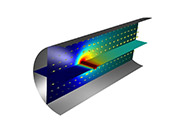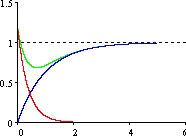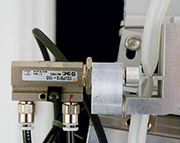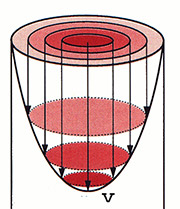Flow patterns of gases and liquids
 Formulations or problems in fluid mechanics can be resolved numerically or analytically. Standard CFD software makes a numerical calculation. However, if a specific optimum flow is to be achieved or if full control over the calculation process is required, analytical calculations have to be made that are precisely tailored to the problem. For this purpose, special mathematical knowledge – e.g. about (partial) differential equations – as well as an understanding of the underlying physics are required.
Formulations or problems in fluid mechanics can be resolved numerically or analytically. Standard CFD software makes a numerical calculation. However, if a specific optimum flow is to be achieved or if full control over the calculation process is required, analytical calculations have to be made that are precisely tailored to the problem. For this purpose, special mathematical knowledge – e.g. about (partial) differential equations – as well as an understanding of the underlying physics are required.
Example 1: Gas flows
 A medical device manufacturer had produced a pressure vessel having an outlet. It was decided that the pressure vessel should be enlarged. The issue to be resolved was how temporal pressure decrease would vary with a change in container size. This question was answered successfully and in its entirety. Results from the kinetic theory of gases were used for this purpose. In addition, a method was developed that allowed a practical check for accuracy of the calculations to be carried out on the predecessor pressure vessel.
A medical device manufacturer had produced a pressure vessel having an outlet. It was decided that the pressure vessel should be enlarged. The issue to be resolved was how temporal pressure decrease would vary with a change in container size. This question was answered successfully and in its entirety. Results from the kinetic theory of gases were used for this purpose. In addition, a method was developed that allowed a practical check for accuracy of the calculations to be carried out on the predecessor pressure vessel.
Example 2: Liquid flows
 A liquid was dispensed through a tube into small glass bottles. The liquid flow was regulated by a controllable clamp. The issue to be resolved here was how wide and for how long the clamp has to be kept open to ensure that the bottles contain a precisely prescribed volume of liquid.
A liquid was dispensed through a tube into small glass bottles. The liquid flow was regulated by a controllable clamp. The issue to be resolved here was how wide and for how long the clamp has to be kept open to ensure that the bottles contain a precisely prescribed volume of liquid.
 The answer was obtained by applying a generalised version of the Hagen-Poiseuille equation. This involved calculating the Reynolds number for the constriction to ensure that the flow remains laminar.
The answer was obtained by applying a generalised version of the Hagen-Poiseuille equation. This involved calculating the Reynolds number for the constriction to ensure that the flow remains laminar.
Image sources:
Image 1: © COMSOL
Image 3: © Guido Schwartenbeck
Image 4: © Prof Wolfgang Demtröder



